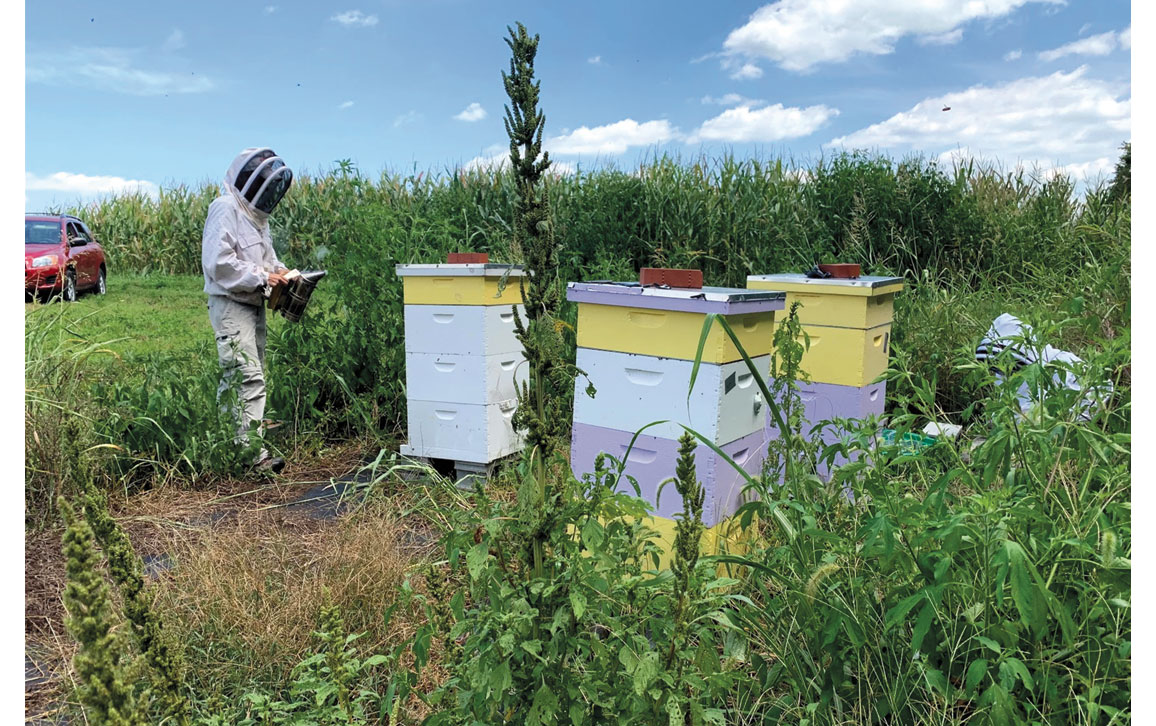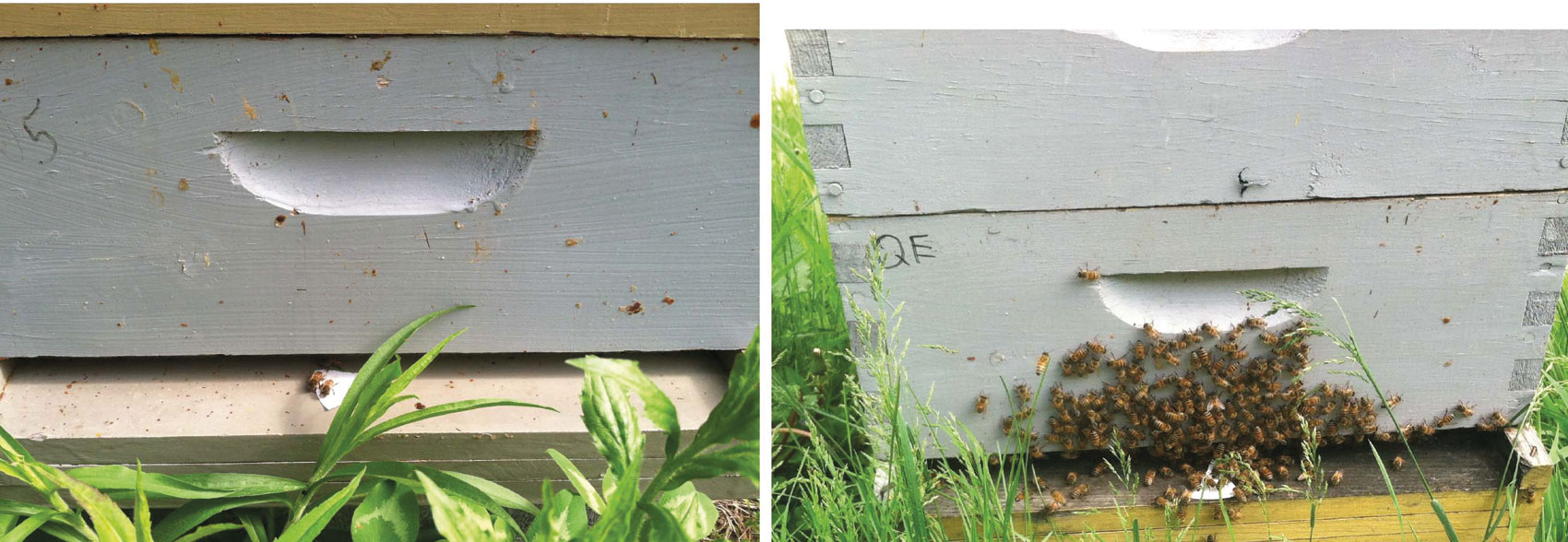Why Gentle Honeybee Hives Are Less Resilient
By Katie L. Burke
Bees that tend not to sting show a molecular profile associated with infection and stress, even though they are healthy.
Bees that tend not to sting show a molecular profile associated with infection and stress, even though they are healthy.

Animal behaviorist Clare Rittschof of the University of Kentucky has been studying honeybee aggression for more than 10 years, so it might come as no surprise that she’s lost count of the number of times she’s been stung. But she used to keep count. “I got 88 honeybee stings just in one summer,” she recalls.
That’s because it can actually be better for her and the bees if she does occasionally get stung. “I don’t really go for 100 percent no sting,” she says. “I don’t wear gloves or anything on my hands, because I find it easier to handle the bees. Also, if you get a few stings here and there, it can help maintain a lower reaction level.” Safety comes first in her lab, of course, and sting management is a part of it. “You’re going into the nest, into the lion’s den. You don’t necessarily observe from a safe distance,” she says. “It takes a long time to train students.” But experiencing honeybee aggression is not just a by-product of her research—it’s a focus.

Stephanie Flout
Studies have shown that low-aggression hives have higher mortality rates than high-aggression ones. Scientists across many disciplines are trying to figure out why honeybee colonies are dying at historically high rates. Many stressors—such as infections, pesticides, and a lack of nutritious food—contribute to this mortality. Understanding those synergistic effects of stress, and what they have to do with low aggression, could help curb colony losses. In a recent study published in BMC Genomics, Rittschof identified the molecular reasons that low-aggression bee hives are more susceptible to stressors. (In this case, Rittschof is not talking about “killer bees,” which are especially aggressive hybrids between the European honeybee and the East African lowland honeybee.)
A 2017 study also in BMC Genomics co-led by Christina Grozinger of Pennsylvania State University and Robert J. Paxton of the Martin Luther University Halle-Wittenberg in Germany had identified genes expressed in unhealthy honeybees regardless of the source of stress or infection, demonstrating that stressed-out bees share a physiological signature of immune function. They found that 57 genes are consistently upregulated regardless of the source of infection, and about 110 are consistently downregulated. In her new study, Rittschof says her team’s goal was “to identify the molecular signature of aggression, and then to determine the degree to which those genes overlap with genes that are regulated by infection.”
Rittschof and her lab’s previous work laid the groundwork for such an experiment. A 2015 paper she led, published in Scientific Reports, showed that genetically identical bee siblings placed as larvae or pupae in low- and high-aggression colonies develop similar aggression levels to their surrounding colonies—suggesting that environmental cues during larval development, not just genetics, influence how aggressive a bee is.
“Dr. Rittschof’s work has shown that the social environment of the colony profoundly changes the behavior of bees that are reared in it, regardless of the genotypic background of the bees,” says Grozinger, who was not involved with Rittschof’s latest study. “This finding is truly remarkable, since honeybees undergo complete metamorphosis, and thus there are tremendous changes from the larval to adult state.”

Clare Rittschof
Honeybees living in environments with more predators are primed to be hypersensitive to threats. Honeybees have evolved an alarm pheromone response (which Rittschof says smells like bananas) to communicate threats and fight off large predators such as bears. When honeybees sense the alarm pheromone, it changes the bees’ gene expression patterns in the short term and induces them to fight off the predator. In the long term, these gene expression patterns presumably make the bees more sensitive to potential threats. “The role that those expression changes are playing in the brain is not clear,” says Rittschof, and a big part of her lab’s work is unraveling those patterns.
The new study analyzed what genes were expressed among bees raised in the high- or low-aggression hives, using samples from the brain, fat body, and midgut—body parts associated with behavior, pesticide detoxification, and immune response, respectively. Rittschof’s team found that there was indeed an overlap between the genes expressed during infection or stress and those expressed among bees from low-aggression hives. “There’s a physiological profile of stress, regardless of the stressor,” Rittschof explains. “Low-aggression individuals share that profile, and that potentially predisposes them to mortality when there are additional stressors.” The low-aggression bees were otherwise healthy. But some of the genes they expressed were the same as those expressed by unhealthy bees. “The link between aggression and health is very surprising,” says Grozinger, “and this study solidifies this connection at the molecular level. We have undoubtedly selected for ‘gentleness’ in our bee populations, and it is interesting to think that we may have unknowingly also selected for bees that were less resilient.”
But before beekeepers start breeding more aggressive strains, researchers need to understand more about what’s going on. “As with all such studies,” Grozinger says, “it would be valuable to be able to do this on a larger scale, using bees from different populations and subspecies. African and Africanized honeybees, for example, are both more aggressive and resilient to stressors than European bees. Is this a result of this molecular link between aggression and immunity?”
This study is the latest in more than a decade of Rittschof’s work to bring together the field of animal behavior with neuroscience and genomics. Because the honeybee’s genome, nervous system, and behavior are well studied, they are a great model for understanding the behavioral, genetic, and neuroscientific underpinnings of aggression. “Most animals behave aggressively in some kind of context,” Rittschof says, “so presumably aggression has deep evolutionary origins.” Rittschof’s work bolsters this idea: A 2014 paper she published with colleagues in the Proceedings of the National Academy of Sciences of the U.S.A. showed that aggressive social interactions activate the same molecular responses in honeybees, fish, and mice.
Aggressive social interactions activate the same molecular responses in honeybees, fish, and mice.
Rittschof’s research trajectory has required her to learn all sorts of interdisciplinary skills, from keeping bees to sequencing genomes and transcriptomes. “I started out being interested in the evolution of behavior, and then got interested in how animals can make decisions in a complicated environment, which led me to study the brain,” she says. “Several years before I was making that transition, the human genome was published. One insight that came out from that project was that what makes animals different is not always our gene content, but how genes are expressed. That synergized with my interest as well, and I got really fascinated by the idea that the environment changes how your genome functions.”
As Rittschof and her team examine these processes, not only could her work help inform how to curb the rise in honeybee mortality, but also it could have implications for our understanding of other animals’ neuroscience and behaviors, including those of humans. “Most diseases of cognitive decline, such as dementia, Alzheimer’s, and Parkinson’s, involve metabolic dysfunction in the brain,” Rittschof says. “We’re looking at how variation in energy use [in the brain] is related to a natural, healthy behavioral phenotype, such as we see in high-aggression bees.” Her lab is now working on studying not only the relationship between aggression and health at the molecular level, but also honeybees’ energy use in the brain and their nutritional ecology.
Click "American Scientist" to access home page
American Scientist Comments and Discussion
To discuss our articles or comment on them, please share them and tag American Scientist on social media platforms. Here are links to our profiles on Twitter, Facebook, and LinkedIn.
If we re-share your post, we will moderate comments/discussion following our comments policy.